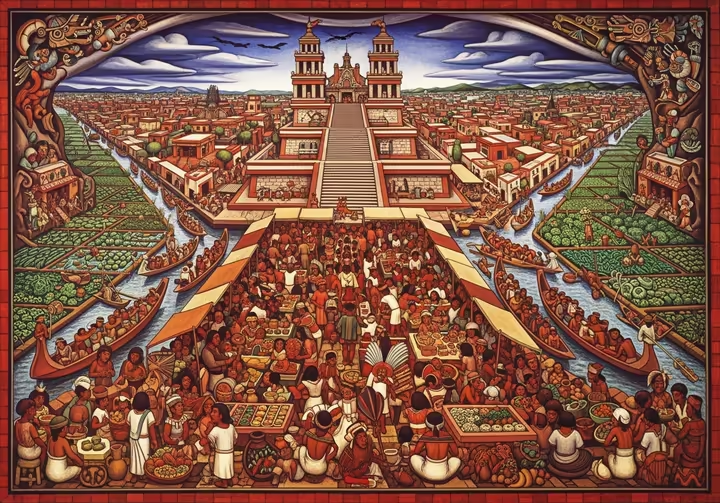Aztec Art: Gods, Gore, and Glory
The people you probably know as the Aztecs, the Mexica, built a huge empire in what is now Mexico. They did it fast. And to understand them, you have to look at their art, which was deeply connected to their culture and religion.
Aztec art had a job to do. It was a tool for religion, a billboard for government power, and a way to talk to the gods.
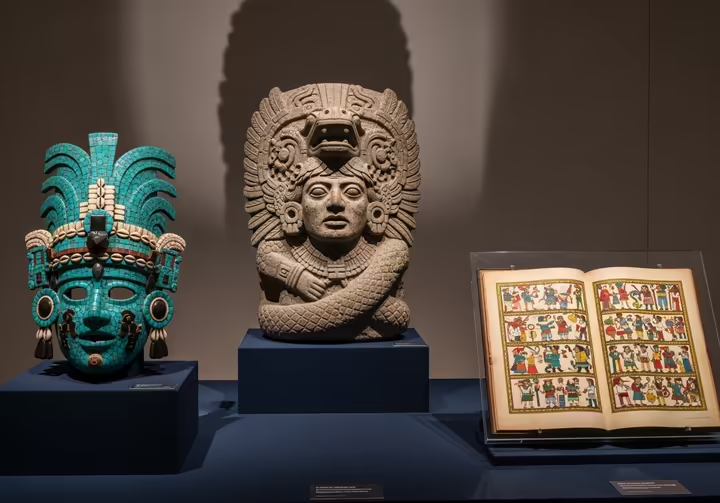
Art with a Purpose
Purpose and Power
The Aztecs believed the universe was a wobbly, unstable place. To keep it from falling apart, they had to perform rituals to please a lot of powerful gods. Art was how they did it.
Every piece expressed a religious idea or a myth using a shared visual language. An eagle was never just a bird, it represented the sun and the elite warriors who fought for it.
This religious purpose was tied directly to politics. The Mexica were new to the area, so they used art to look powerful and legitimate. Giant, terrifying sculptures in temples were meant to scare subjects and enemies into line.
The Toltec Tradition
The Aztecs really admired the Toltecs, an earlier civilization in central Mexico. They saw the Toltecs as master craftsmen. The Nahuatl word for the Toltec people, Tōltēkatl , even became the word for "artisan."
By claiming this artistic heritage, the Aztecs positioned themselves as the rightful heirs to the culture of the region.
Master artisans were respected and organized into guilds, but priests and rulers kept them on a tight leash. Artists had to create propaganda and religious icons for the state. This system guaranteed a steady flow of magnificent, state-approved art.
Big, Stone, Stories
The most famous Aztec art is the huge stone sculptures, carved from volcanic rock with stone and copper tools. These sculptures were active parts of state rituals. They turned temples into stages for performing cosmic myths.
The Sun Stone
You've probably seen the Sun Stone, often mislabeled the Calendar Stone. This massive basalt disk is actually a diagram of the Aztec cosmos. At the center is a terrifying face, maybe the sun god Tonatiuh, gripping human hearts.
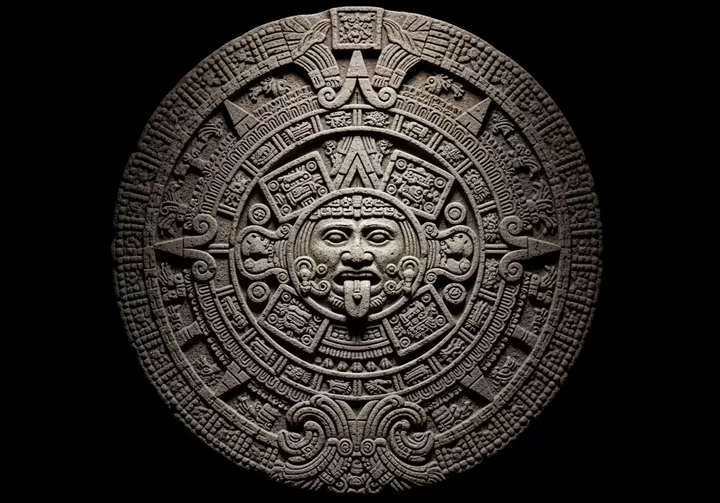
The four squares around the center show the four previous universes, or "Suns," which all ended in disaster (devoured by jaguars, destroyed by hurricanes, etc.). The stone is a giant reminder that the current world, the Fifth Sun, could end at any moment. It was likely used as a sacrificial altar, linking human blood to the story of cosmic survival.
The Coyolxāuhqui Stone
This stone tells the crazy origin story of the Aztec's main god, Huitzilopochtli. The story goes that his mother, the goddess Coatlicue, became pregnant from a ball of feathers. Her daughter, Coyolxāuhqui ("Bells-on-her-face"), and 400 sons were outraged and planned to kill her.
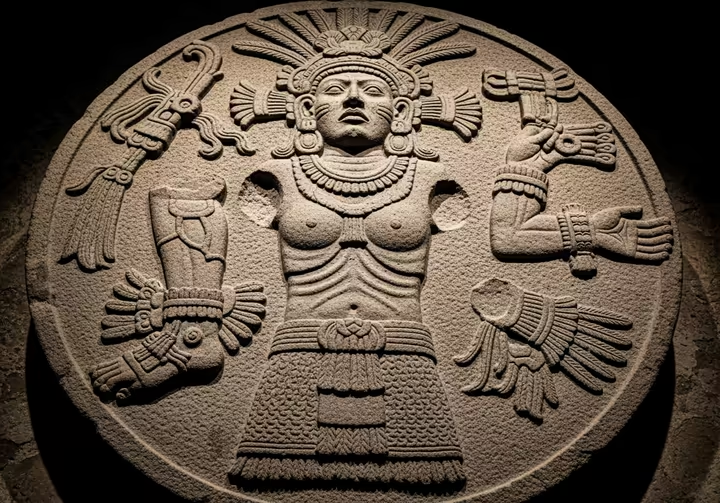
But just as they attacked, Huitzilopochtli sprang from the womb, fully grown and armed. He promptly chopped up his sister Coyolxāuhqui and threw her body down a mountain. The stone shows her dismembered and humiliated, and it was placed at the bottom of the Templo Mayor, Huitzilopochtli's temple.
When sacrificial victims were rolled down the temple steps, they landed on this stone. This theatrically re-enacted the myth, showing the victory of the Aztecs' god in a pretty gruesome way.
The Coatlicue Statue
The statue of Coatlicue ("She of the Serpent Skirt") is the earth mother goddess. She is both the creator of life and the devourer of the dead. Think Mother Nature, if she wore a necklace of severed hands and human hearts.
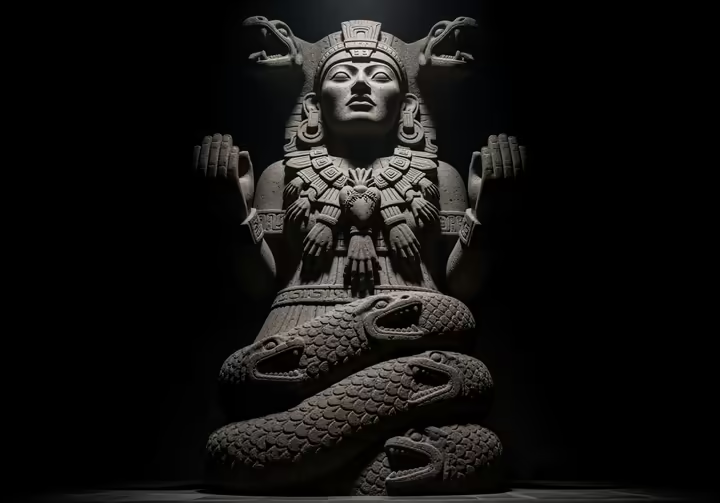
Her head is made of two giant serpents, and her skirt is a tangle of writhing snakes. Her hands and feet are claws for digging graves. The statue is a powerful symbol of the cycle of life and death, not a realistic portrait.
Books without Words
Besides the big stone sculptures, the Aztecs also made painted books, or codices. These were made by the tlacuilo , a painter-scribe. For the Aztecs, painting and writing were the same thing.
How They Were Made
These books were made from paper called amate (from fig tree bark) or prepared deerskin, folded like an accordion. The tlacuiloque used pigments from crushed cochineal insects for red, flowers for yellow, and pine soot for black.
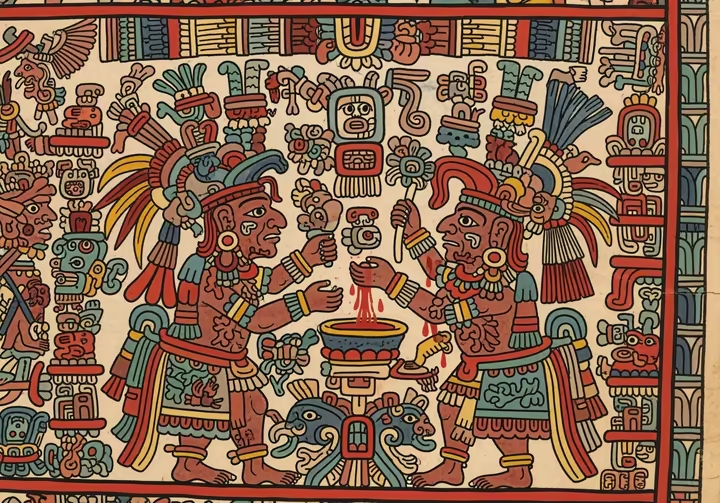
The style is distinct, flat areas of bright color with strong, black outlines. There's no shading, just bold shapes and symbols.
What They Were For
The codices recorded everything. Some were histories, tracking the lineage of rulers and their conquests. Others were religious almanacs that dictated the right time for ceremonies, farming, and war.
The most important ones for the empire were the tribute lists. These were basically spreadsheets made of pictures, detailing exactly what goods each conquered province owed to Tenochtitlan. They tracked massive quantities of feathers, cacao, textiles, and food flowing into the capital.
Buildings with a Message
Aztec architecture was designed to be a spectacle. The ceremonial center of Tenochtitlan was built to make the Mexica feel proud and their enemies feel small and scared. At its heart was the Templo Mayor, the Great Temple.
The Templo Mayor
The Templo Mayor was a man-made sacred mountain, representing Coatepec ("Snake Mountain"), where Huitzilopochtli was born. It was the center of the Aztec universe, the spot where the heavens, earth, and underworld all met. The temple was a massive pyramid, about 60 meters high.
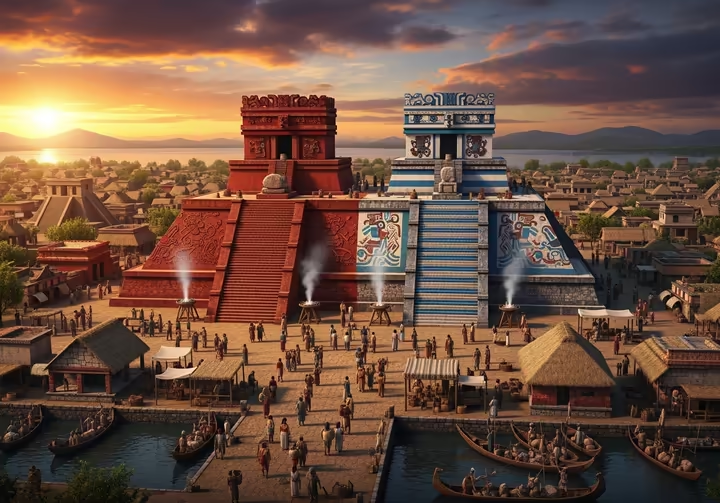
It had two shrines at the top. The southern shrine (painted red) was for Huitzilopochtli, the god of sun and war. The northern shrine (painted blue and white) was for Tlaloc, the god of rain and farming. Together, they represented atl-tlachinolli , or "burnt water," a metaphor for the sacred war that balanced conquest and agriculture.
The Skull Rack
The area around the temple was full of art, like the serpent balustrades on the stairways. Nearby stood the tzompantli , or skull rack. Yes, it's exactly what it sounds like, a huge wooden rack where the skulls of thousands of sacrificial victims were put on display.
Some Spanish accounts even describe towers built from skulls and mortar. The tzompantli was a brutal and clear message, honoring the gods and warning anyone who might challenge the empire. Imagine the whole scene, bright pyramids, incense smoke, and a giant wall of skulls... it was powerful stuff.
More Valuable Than Gold
While the Aztecs were masters of stone, they valued other materials more. Preciousness was about rarity, beauty, and a connection to the gods, not permanence. Things like feathers and turquoise were often worth more than gold.
Featherwork
The most prized craft was featherwork, done by artisans called the amanteca . Using feathers from tropical birds, they created stunning shields, headdresses, and fans. One technique involved a "feather painting" mosaic, where thousands of tiny feather fragments were glued to a backing to create shimmering images.
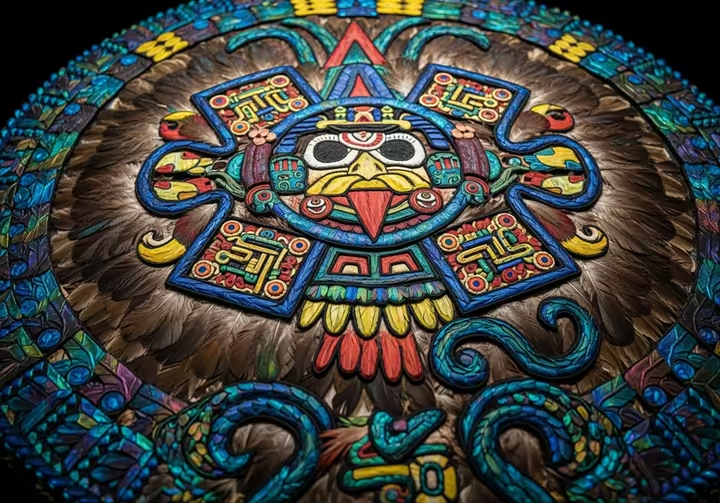
The long green tail feathers of the quetzal bird were the most valuable item in the empire. They were linked to the god Quetzalcoatl and were thought to be literal shadows of the deities on earth.
Turquoise Mosaics
Just as valuable was turquoise mosaic. Artists would fit hundreds of tiny pieces of turquoise onto a wooden base, often a ceremonial mask. The mask of the fire god Xiuhtecuhtli ("Turquoise Lord") is a famous example, with eyes of mother-of-pearl and teeth of conch shell.
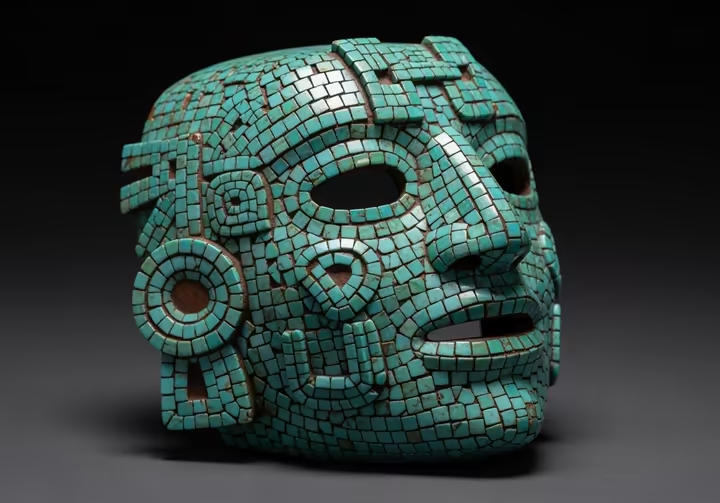
Another incredible piece is a real human skull covered in alternating bands of turquoise and black lignite. It likely represents the god Tezcatlipoca ("Smoking Mirror"), and yes, it's just as creepy and cool as it sounds. These materials came from the farthest edges of the empire, which only added to their value.
The Aztec Style
Across all these different media, Aztec art has a unique style. It ranges from very realistic to wildly abstract, all to communicate ideas about the universe.
Realism Meets Abstraction
Aztec artists could be incredibly realistic, carving perfect grasshoppers from jade. But when it came to gods, they went abstract. Deities were shown as mash-ups of symbolic parts instead of simple human figures.
This shows their belief that the visible world was controlled by an invisible, supernatural one.
A Coded Language
The style is bold and clear. Artists used flat, bright colors with strong outlines, giving the art an immediate impact. Every element was part of a symbolic code.
The core theme is duality, life and death, creation and destruction. The universe was seen as fragile, and only constant sacrifice could keep it going. This belief made their art both beautiful and terrifying.
The Aftermath
The Aztec artistic world came to a sudden, violent end with the Spanish conquest in 1521. The conquistadors saw the art as devil-worship and set out to destroy it. They tore down the temples to build their own churches and melted down priceless gold and silver objects.
Thousands of irreplaceable codices were burned by missionaries. It was a conscious effort to destroy an entire system of knowledge.
Survival and Rebirth
But the tradition didn't completely die. Spanish priests hired the surviving tlacuiloque to create new manuscripts. In books like the Florentine Codex, a cool hybrid style emerged, mixing old Aztec symbols with new European techniques like shading and perspective.
For centuries, Aztec art was mostly forgotten. But after the Mexican Revolution in the early 20th century, artists looked to their country's pre-Hispanic past for inspiration. The bold forms and epic stories of Aztec art became a huge influence on the Mexican Muralism movement.
Artists like Diego Rivera rejected European styles and embraced a style rooted in indigenous traditions. His giant murals are filled with Aztec imagery, celebrating Mexico's heritage and telling a new history of the nation. The art of the Aztecs, once targeted for destruction, was reborn as a powerful symbol of modern Mexican culture.
